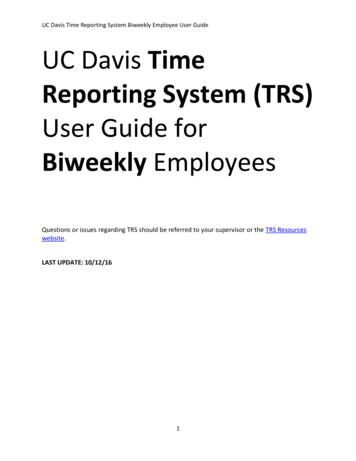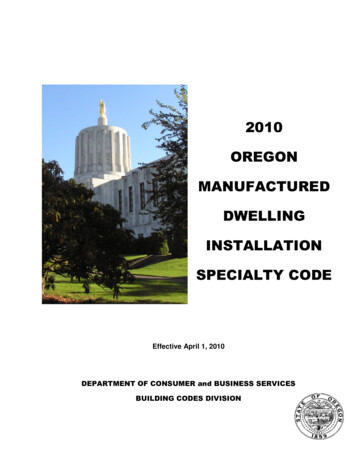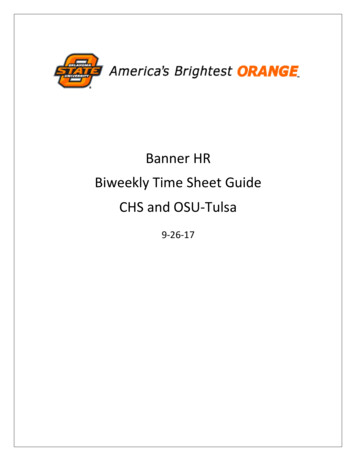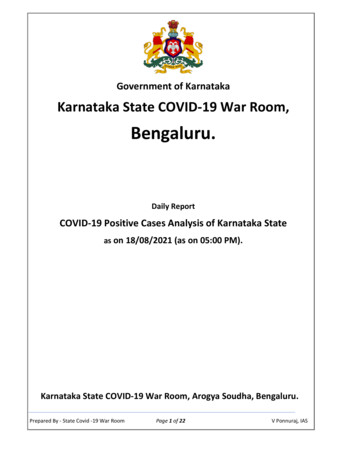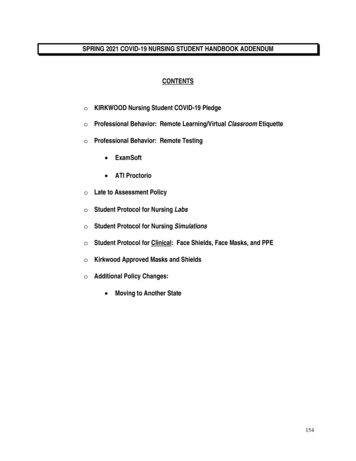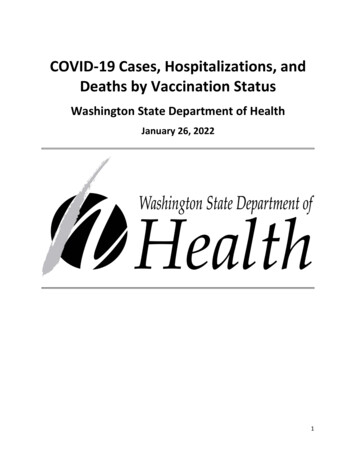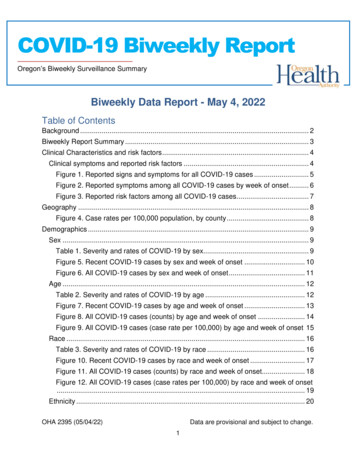
Transcription
COVID-19 Biweekly ReportOregon’s Biweekly Surveillance SummaryNovel Coronavirus (COVID-19)Biweekly Data Report - May 4, 2022Table of ContentsBackground . 2Biweekly Report Summary . 3Clinical Characteristics and risk factors . 4Clinical symptoms and reported risk factors . 4Figure 1. Reported signs and symptoms for all COVID-19 cases . 5Figure 2. Reported symptoms among all COVID-19 cases by week of onset . 6Figure 3. Reported risk factors among all COVID-19 cases . 7Geography . 8Figure 4. Case rates per 100,000 population, by county . 8Demographics . 9Sex . 9Table 1. Severity and rates of COVID-19 by sex. 9Figure 5. Recent COVID-19 cases by sex and week of onset . 10Figure 6. All COVID-19 cases by sex and week of onset . 11Age . 12Table 2. Severity and rates of COVID-19 by age . 12Figure 7. Recent COVID-19 cases by age and week of onset . 13Figure 8. All COVID-19 cases (counts) by age and week of onset . 14Figure 9. All COVID-19 cases (case rate per 100,000) by age and week of onset 15Race . 16Table 3. Severity and rates of COVID-19 by race . 16Figure 10. Recent COVID-19 cases by race and week of onset . 17Figure 11. All COVID-19 cases (counts) by race and week of onset. 18Figure 12. All COVID-19 cases (case rates per 100,000) by race and week of onset. 19Ethnicity . 20OHA 2395 (05/04/22)Data are provisional and subject to change.1
COVID-19 Biweekly ReportOregon’s Biweekly Surveillance SummaryNovel Coronavirus (COVID-19)Table 4. Severity and rates of COVID-19 by ethnicity . 20Figure 13. Recent COVID-19 cases by ethnicity and week of onset . 21Figure 14. All COVID-19 cases (counts) by ethnicity and week of onset . 22Figure 15. All COVID-19 cases (case rates per 100,000) by ethnicity and week ofonset . 23Age-adjustment. 24Table 5. Ratio of age-adjusted rates for cases, hospitalizations, and deaths by race. 24Table 6. Ratio of age-adjusted rates for cases, hospitalizations, and deaths byethnicity . 25People with Intellectual and Developmental Disabilities . 25Weekly COVID-19 Hospitalizations (HOSCAP) . 26ZIP code . 26BackgroundCOVID-19 Biweekly Report data will be finalized every other Sunday at 11 p.m. PST,and the report will be published every other week on Wednesday. Please note that thedata reported here are continually being updated. For daily up-to-date information, visitthe OHA COVID-19 web page: https://govstatus.egov.com/OR-OHA-COVID-19.As of 11 p.m. Sunday, May 1, there have been 723,334 cases of COVID-19 reported tothe Oregon Health Authority. Of these, 26,123 (3.6%) are “presumptive” cases. Thisincludes people with COVID-19-like symptoms and close contact with a confirmed case,but who did not have a confirmatory laboratory test, and people that self-report at-hometests to public health. Though not confirmed, presumptive cases are highly likely to haveCOVID-19, given their specific symptoms and known exposure or at-home positive test.If a case later tests positive at a lab, that case will be recategorized as confirmed. If acase tests positive at home, the case will remain presumptive.These data represent a snapshot of COVID-19 risk factors and clinical anddemographic characteristics of cases, and they include data on cases with pendingOHA 2395 (05/04/22)Data are provisional and subject to change.2
COVID-19 Biweekly ReportOregon’s Biweekly Surveillance SummaryNovel Coronavirus (COVID-19)investigations. Not all cases have been interviewed at the time of this report. It isimportant to note that as of 1/11/2022, case investigation and contact tracing operationshave been modified to prioritize outbreaks in high-consequence settings, such ashealthcare, congregate care (e.g., nursing homes), corrections and settings related toour food chain. Public health is no longer calling all cases to attempt interview to assesssymptoms and risks. The data shown in this report come from Oregon’s electronicdisease surveillance system for reportable diseases.During the weeks of April 17–April 301, 173,792 tests for COVID-19 were performed onOregonians; of these, 7.7% had a positive result.2 This figure represents a “test-based”method, whereby all electronic lab reports received by OHA are used to calculatepercent positivity.3 Detailed tables of the number of tests and percent positivity can befound online .Biweekly Report SummaryDuring Monday, April 18, through Sunday, May 1, 2022, OHA logged 12,234 new casesof COVID-19 infection—more than double the previous fortnightly total of 5,980. Thisincrease comes as reported test results increased 20%, and the proportion positiveincreased from 3.6% to 7.7%.Two hundred eighteen new COVID-19-associated hospitalizations were reported toOHA during the most recent two weeks—up from 202 reported during the preceding 2week period. In addition, OHA has added more than 500 previously unidentifiedhospitalizations from before April 2021. These hospitalizations were identified during aperiodic review of Oregon hospital discharge records, wherein OHA searches for1This date range aligns with CDC’s “MMWR week.”2Does not include antibody (serology) rces/calculating-percent-positivity.htmlOHA 2395 (05/04/22)Data are provisional and subject to change.3
COVID-19 Biweekly ReportOregon’s Biweekly Surveillance SummaryNovel Coronavirus (COVID-19)previously unidentified hospitalizations by comparing public health data with confirmedpatient records.Fifty COVID-19-associated deaths were reported during these past two weeks—79%fewer than the 241 reported during the prior two weeks. Of the 723,334 COVID-19cases reported in Oregon to date, 30,105 (4.2%) have been hospitalized, and 7,505(1.0%) have died. Sixty-six percent of the COVID-19-associated deaths have been inOregonians 70 years of age or older, and 6.3% in persons younger than 50. Data onmortality in Oregon, including deaths associated with COVID-19, are available r.health.statistics.Additional data are available ata.Clinical Characteristics and risk factorsThis section of the report describes the epidemiology of Oregon’s COVID-19 cases,including common symptoms experienced by COVID-19 cases, and demographicbreakdowns for sex, age, race, and ethnicity. Indicators of disease severity, specificallyhospitalizations and deaths, are included in the tables.Clinical symptoms and reported risk factorsFigure 1 provides information on signs and symptoms from all COVID-19 cases. Of723,334 cases, 242,406 (33.5%) reported having signs and symptoms of COVID-19.The most commonly reported symptoms are cough (n 129,928, 18%) and headache(n 101,785, 14.1%). Figure 2 provides information on the percentage of COVID-19cases that report symptoms over time. Figure 3 provides information on risk factors fromall COVID-19 cases. The most common risk factors are having contact with a knownCOVID-19 case prior to symptom onset (n 182,407, 25.2%) and having underlyingmedical conditions (n 550,418, 76.1%). Note that a person may report more than onesign/symptom or risk factor. Where displayed by week in this report, case data arecategorized by week of reported symptom onset, not by date of case report. This resultsin reduced numbers in the most recent week or more due to reporting lags.Additional data are available alth.authority.covid.19/viz/OregonCOVIOHA 2395 (05/04/22)Data are provisional and subject to change.4
COVID-19 Biweekly ReportOregon’s Biweekly Surveillance SummaryNovel Coronavirus iz/OregonCOVID-19Update/DailyDataUpdate.Figure 1. Reported signs and symptoms for all COVID-19 casesOHA 2395 (05/04/22)Data are provisional and subject to change.5
COVID-19 Biweekly ReportOregon’s Biweekly Surveillance SummaryNovel Coronavirus (COVID-19)Figure 2. Reported symptoms among all COVID-19 cases by week of onsetOHA 2395 (05/04/22)Data are provisional and subject to change.6
COVID-19 Biweekly ReportOregon’s Biweekly Surveillance SummaryNovel Coronavirus (COVID-19)Figure 3. Reported risk factors among all COVID-19 casesRisk factor definitions: Congregate living situations include, but are not limited to, long-term carefacilities, group homes, prisons, and shelters. Data include people with confirmedcases who live or work in congregate living situations. Direct patient care is only asked if a case is a healthcare worker or volunteer.The denominator is the number of healthcare workers or volunteers. Underlying medical conditions include cardiovascular disease, chronic liverdisease, chronic lung disease, chronic renal disease, current or former smoker,diabetes mellitus, immunocompromised condition, neurologic andneurodevelopmental conditions, obesity, or other chronic diseases.OHA 2395 (05/04/22)Data are provisional and subject to change.7
COVID-19 Biweekly ReportOregon’s Biweekly Surveillance SummaryNovel Coronavirus (COVID-19)GeographyThe following figure shows case rates by county for the most recently completedMMWR weeks, which are currently April 17 to April 30, 2022. Cases are displayed usingthe date that the case became known to public health.Figure 4. Case rates per 100,000 population, by countyOHA 2395 (05/04/22)Data are provisional and subject to change.8
COVID-19 Biweekly ReportOregon’s Biweekly Surveillance SummaryNovel Coronavirus (COVID-19)1.Counties that had case rates above the case rate for the state are displayed inorange. Counties that had case rates below the case rate for the state aredisplayed in blue.2.Counties that had zero cases in the time period displayed appear on the list, butdo not have a bar to display.3.Additional data are available sbyCounty.DemographicsThe following tables and figures show the demographic characteristics for all COVID-19cases. The tables show case counts, case rates, and indicators of severity by sex, age,race and ethnicity. The figures show cases over time, by week of onset, for sex, age,race, and ethnicity. Figure 4 displays case rates by county, in comparison to the caserate for all of Oregon.SexTable 1. Severity and rates of COVID-19 by sexCases% of totalcasesCases per100,000Hospitalized% 947.6Rates are calculated using population estimates from the 2020 AnnualPopulation Report from Portland State University’s College of Urban & PublicOHA 2395 (05/04/22)Data are provisional and subject to change.9
COVID-19 Biweekly ReportOregon’s Biweekly Surveillance SummaryNovel Coronavirus (COVID-19)Affairs Population Research Center and 2019 housing and demographic datafrom the U.S. Census Bureau’s American Community Survey (ACS).2.Additional data are available Hosp?publish yes.Figure 5. Recent COVID-19 cases by sex and week of onsetOHA 2395 (05/04/22)Data are provisional and subject to change.10
COVID-19 Biweekly ReportOregon’s Biweekly Surveillance SummaryNovel Coronavirus (COVID-19)Figure 6. All COVID-19 cases by sex and week of onsetOHA 2395 (05/04/22)Data are provisional and subject to change.11
COVID-19 Biweekly ReportOregon’s Biweekly Surveillance SummaryNovel Coronavirus (COVID-19)AgeTable 2. Severity and rates of COVID-19 by ageAgegroupCases% of totalcasesCases per100,000Hospitalized% 1.95,93617.01,8635.380 ,947.61.Rates are calculated using population estimates from the 2020 AnnualPopulation Report from Portland State University’s College of Urban & PublicAffairs Population Research Center and 2019 housing and demographic datafrom the U.S. Census Bureau’s American Community Survey (ACS).2.Additional data are available Hosp?publish yes; s.OHA 2395 (05/04/22)Data are provisional and subject to change.12
COVID-19 Biweekly ReportOregon’s Biweekly Surveillance SummaryNovel Coronavirus (COVID-19)Figure 7. Recent COVID-19 cases by age and week of onsetOHA 2395 (05/04/22)Data are provisional and subject to change.13
COVID-19 Biweekly ReportOregon’s Biweekly Surveillance SummaryNovel Coronavirus (COVID-19)Figure 8. All COVID-19 cases (counts) by age and week of onsetOHA 2395 (05/04/22)Data are provisional and subject to change.14
COVID-19 Biweekly ReportOregon’s Biweekly Surveillance SummaryNovel Coronavirus (COVID-19)Figure 9. All COVID-19 cases (case rate per 100,000) by age and week of onsetOHA 2395 (05/04/22)Data are provisional and subject to change.15
COVID-19 Biweekly ReportOregon’s Biweekly Surveillance SummaryNovel Coronavirus (COVID-19)RaceTable 3. Severity and rates of COVID-19 by raceCases% of totalcasesCases per100,000Hospitalized% otal723,334100.016,947.630,1054.27,5051.0Race 1 raceNot AvailableOtherPacific Islander1.During the case investigation, people are asked to self-report their race, ethnicity,tribal affiliation, country of origin, or ancestry.2.Rates are calculated using population estimates from the 2020 AnnualPopulation Report from Portland State University’s College of Urban & PublicAffairs Population Research Center and 2019 housing and demographic datafrom the U.S. Census Bureau’s American Community Survey (ACS).3.Persons for which race information was not available were not included in theseestimates. The number of persons with race data unavailable can be found inTable 3.4.60,374 (68.9%) of the 87,563 persons who identify as “Other” race also selfidentify as Hispanic or Latino.OHA 2395 (05/04/22)Data are provisional and subject to change.16
COVID-19 Biweekly ReportOregon’s Biweekly Surveillance SummaryNovel Coronavirus (COVID-19)5.Additional data are available Hosp?publish yes; s.Figure 10. Recent COVID-19 cases by race and week of onsetOHA 2395 (05/04/22)Data are provisional and subject to change.17
COVID-19 Biweekly ReportOregon’s Biweekly Surveillance SummaryNovel Coronavirus (COVID-19)Figure 11. All COVID-19 cases (counts) by race and week of onsetOHA 2395 (05/04/22)Data are provisional and subject to change.18
COVID-19 Biweekly ReportOregon’s Biweekly Surveillance SummaryNovel Coronavirus (COVID-19)Figure 12. All COVID-19 cases (case rates per 100,000) by race and week of onsetOHA 2395 (05/04/22)Data are provisional and subject to change.19
COVID-19 Biweekly ReportOregon’s Biweekly Surveillance SummaryNovel Coronavirus (COVID-19)EthnicityTable 4. Severity and rates of COVID-19 by ethnicityEthnicityCases% of totalcasesCases per100,000Hospitalized% HospitalizedDeathsCasefatality 7,5051.016,947.61.Rates are calculated using population estimates from the 2020 AnnualPopulation Report from Portland State University’s College of Urban & PublicAffairs Population Research Center and 2019 housing and demographic datafrom the U.S. Census Bureau’s American Community Survey (ACS).2.Additional data are available Hosp?publish yes; s.OHA 2395 (05/04/22)Data are provisional and subject to change.20
COVID-19 Biweekly ReportOregon’s Biweekly Surveillance SummaryNovel Coronavirus (COVID-19)Figure 13. Recent COVID-19 cases by ethnicity and week of onsetOHA 2395 (05/04/22)Data are provisional and subject to change.21
COVID-19 Biweekly ReportOregon’s Biweekly Surveillance SummaryNovel Coronavirus (COVID-19)Figure 14. All COVID-19 cases (counts) by ethnicity and week of onsetOHA 2395 (05/04/22)Data are provisional and subject to change.22
COVID-19 Biweekly ReportOregon’s Biweekly Surveillance SummaryNovel Coronavirus (COVID-19)Figure 15. All COVID-19 cases (case rates per 100,000) by ethnicity and week ofonsetOHA 2395 (05/04/22)Data are provisional and subject to change.23
COVID-19 Biweekly ReportOregon’s Biweekly Surveillance SummaryNovel Coronavirus (COVID-19)Age-adjustmentTables 5 and 6 show the ratio of age-adjusted rates of COVID-19 for cases,hospitalizations, and deaths by race and ethnicity. Each table compares the rates ofcases, hospitalizations, and deaths between each group and a reference group andaccounts for differences in population distributions in each group.Table 5. Ratio of age-adjusted rates for cases, hospitalizations, and deaths byraceAge-adjusted rate ratios of cases, hospitalizations, and deaths, compared to whitepersons.RaceCasesHospitalizationsDeaths 1 sian0.90.90.8Black1.82.92.1Pacific Islander1.54.13.8White1.01.01.01.During the case investigation, people are asked to self-report their race, ethnicity,tribal affiliation, country of origin, or ancestry.2.U.S. Census Bureau; American Community Survey, 2019 American CommunitySurvey 5-Year Estimates.3.Persons for which race information was not available were not included in theseestimates. The number of persons with race data unavailable can be found inTable 3.4.Additional data are available aReports/Age-AdjustedReport-02-17-2022.pdf.OHA 2395 (05/04/22)Data are provisional and subject to change.24
COVID-19 Biweekly ReportOregon’s Biweekly Surveillance SummaryNovel Coronavirus (COVID-19)Table 6. Ratio of age-adjusted rates for cases, hospitalizations, and deaths byethnicityAge-adjusted rate ratios of cases, hospitalizations, and deaths, compared to spanic1.62.21.8Non-Hispanic1.01.01.01.During the case investigation, people are asked to self-report their race, ethnicity,tribal affiliation, country of origin, or ancestry.2.U.S. Census Bureau; American Community Survey, 2019 American CommunitySurvey 5-Year Estimates.3.Persons for which ethnicity information was not available were not included inthese estimates. The number of persons with ethnicity data unavailable can befound in Table 4.4.Additional data are available aReports/Age-AdjustedReport-02-17-2022.pdf.People with Intellectual and Developmental DisabilitiesAs of January 9, 2022, OHA is aware of 2,397 people with intellectual or developmentaldisabilities who have had COVID-19 to date. This includes individuals who live incongregate settings and in family or individual homes. To date, there are 49 deathsamong people with intellectual or developmental disabilities. This number is fromconducting a match between the ODHS Office of Developmental Disabilities Servicesclient list and the Oregon COVID-19 case database. OHA will update this number on aquarterly basis.Additional information about the ODDS program and COVID-19 can be found here:OHA 2395 (05/04/22)Data are provisional and subject to change.25
COVID-19 Biweekly ReportOregon’s Biweekly Surveillance SummaryNovel Coronavirus al-COVID-19Report.pdf.ODDS data is based on self-reports from providers and case management entities andtherefore may differ from testing data received from the Oregon Health Authority.Weekly COVID-19 Hospitalizations (HOSCAP)OHA is publishing data on the number of COVID-19 hospitalizations by hospital in theprior week; data are from HOSCAP. Maps and tables containing the 7-day average ofhospitalizations by region and hospital are available online lCapacity/HospitalizationbyFacility.Information on Oregon’s current hospital bed capacity by region is available online lCapacity/BedAvailabilitybyRegion.ZIP codeOHA is publishing data on cases at the ZIP code level, available online byZIPCode/OregonsCOVID-19CasesbyZipCode?publish yes.Summary table of all zip codes available ?publish yes.Document accessibility: For individuals with disabilities or individuals who speak alanguage other than English, OHA can provide information in alternate formats such astranslations, large print, or braille. Contact the Health Information Center at 1-971-6732411, 711 TTY or COVID19.LanguageAccess@dhsoha.state.or.us.OHA 2395 (05/04/22)Data are provisional and subject to change.26
tests to public health. Though not confirmed, presumptive cases are highly likely to have COVID-19, given their specific symptoms and known exposure or at-home positive test. If a case later tests positive at a lab, that case will be recategorized as confirmed. If a case tests positive at home, the case will remain presumptive.
